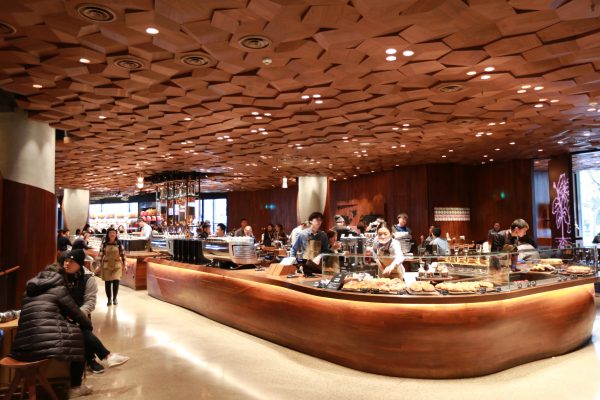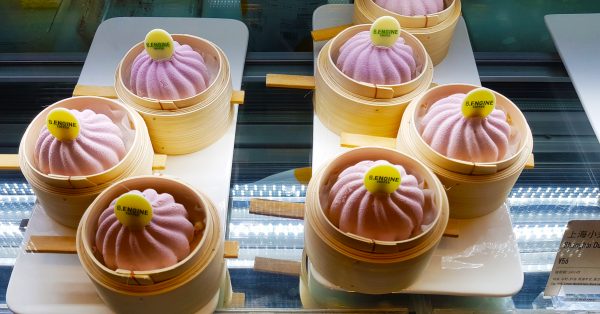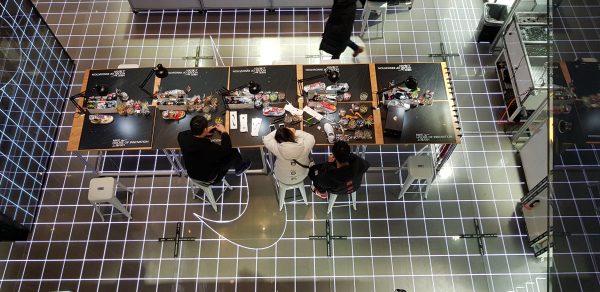Early January we travelled to the future-oriented city Shanghai, to gain insights and inspiration on how Oriental consumers buy, cook and eat. How Chinese food manufacturers, retailers and restaurants anticipate on- and offline to these changes and how that can affect the West. It’s about a coffee revolution, digitalization, new generation supermarkets, ultra-fresh, local cuisines and ‘Weastern’ Food & packaging design.
Shanghai Food trend #1 coffee and tea shops everywhere
Were Chinese traditionally tea drinkers, in recent years a high-speed coffee revolution has taken place. Countless coffee bars have been created throughout the city. From the great Starbucks Roastery experience flagship to small local entrepreneurs who are able to accommodate their bars on a few square meters. Parallel to this, the same revolution has taken place in tea. In traditional tea houses, the pure green, black, oolong and pu’er tea are still being served ritually, but anno 2019 the trendy tea bars with milk tea, fruit tea, bubble tea have appeared on every corner of the street. With the creation of these snack teas, all creativity is unleashed, and the most special taste combination have appeared. Like kumquat pearl tea, mango cream cheese tea and purple potato and jasmine tea. Topped with aerated milk or whipped cream.

Starbucks Roastery experience
Shanghai Food Trend #2 regional and international cuisine
Most restaurants, however, are serving Chinese food. Though we see a clear specialization in one of the eight regional kitchens such as the spicy Szechuan, the aromatic tropical Yunnan and the Cantones cuisine. In Shanghai, the most common kitchen is of course the local Shanghainese, also known as ‘ Benbang cuisine ‘. This is summarized by a mild and slightly sweet taste and uses lots of rice, seafood, fresh vegetables, pickled vegetables, salted meat, sugar and soy. Local food designer Irene Yeh signals a trend that people search again for the flavors of their childhood. In the malls we see many food courts that also serve international cuisines. The vast majority are from Asian origin such as Hong Kong, Singapore, Malaysia, Japan, Korea, Taiwan. Italian was the most frequently spotted cuisine with European roots.

Childhood flavours
Shanghai Food Trend #3 ‘Weastern’ Food and packaging design
West and east come together in the design of food and packaging more and more. On one side the Chines get inspired by the refinement of further East Japan, and on the other side many Western influences are adopted. But often mixed with a Chinese twist. This results in a great Weastern blend in packaging, retail and food design. We spotted for example a beautiful pink cake, which had been shaped like a dumpling and a lapsang soochong tea croissant.

‘Weastern’ Food and packaging design
Retail trend #4 Shopping Malls & Flagship stores
The speed in which Shopping malls have been built in recent years is amazing. Also, the flagship stores of Nike and M&M in the mall on Nanjing Road are giant and impressive. This is where state-of-the-art retailing emerges. On-and offline come together, at both stores you can have products personalized, there are many selfie spots and you can experience the brand in all its details.

Nike flagship store
Retail & Food Trend #5 Digitalization
But who looks and listens well, understands that these shopping temples are already at the end of their heydays. Besides these large physical constructions, the virtual market places are becoming larger and larger every day. For understanding the fast speed of digitalization, it is important to realize that China has a completely different digital ecosystem. Where we have separate search engines, social media platforms, online stores and payment systems, in China this is all fused into a kind of super apps that can do almost anything you imagine. Information, fun, convenience and commerce are interwoven very naturally, and a purchase is only a click away. The post ninety generation is therefore less visiting physical supermarkets. They order their groceries online and within half an hour they get these delivered. Alibaba is opening new Hema supermarkets in all big cities. These are full fygital stores where online and offline seamlessly merge, also called O2O Retailing. At Hema you can buy very fresh produce at a good price or have it delivered within half an hour. Order picking does not happen in large distribution centers, but in the shops themselves. There, employees are collecting the groceries in bags that, via a conveyor belt along the ceiling, find the way to one of the thousands of deliverers. That’s how they manage to create a dense, fast and extremely efficient network.

China’s digital ecosystem
Optimism
Chinese are optimistic about the future. They are proud of their country and look forward confidently. They have been transformed from ‘ rich ‘ to ‘ strong ‘. The new generation wants to enjoy more and make life more pleasurable and easier. We also see that confidence among entrepreneurs. When they see an opportunity, they will go for it. They dare to start with ‘ good enough ‘ in trust that they will learn on the way how to do it better. Chinese organizations are less democratic, if the boss decides then they will do it. Without arguing. This may seem less democratic in our view, but it gives them tremendous strength to realize changes fast.
Curious about more?
It was a wonderful inspirational journey in which we gained many insights into the rich Chinese food culture, state-of-the-art retailing and digitalization. We will turn these insights between West and East, past and future, off-and online into new and strong food brands, formulas, concepts and products. Curious about the whole story? Please contact us for an inspiring trend presentation or a tailormade innovation process.
Many thanks to Dennis Potgraven (Havas Group Shanghai), Ian Bennink and Eva Ding (Open Desk), our Food friends Jing Tang and Leo (M&M desserts) and Irene Yeh (Yimi Lab).

